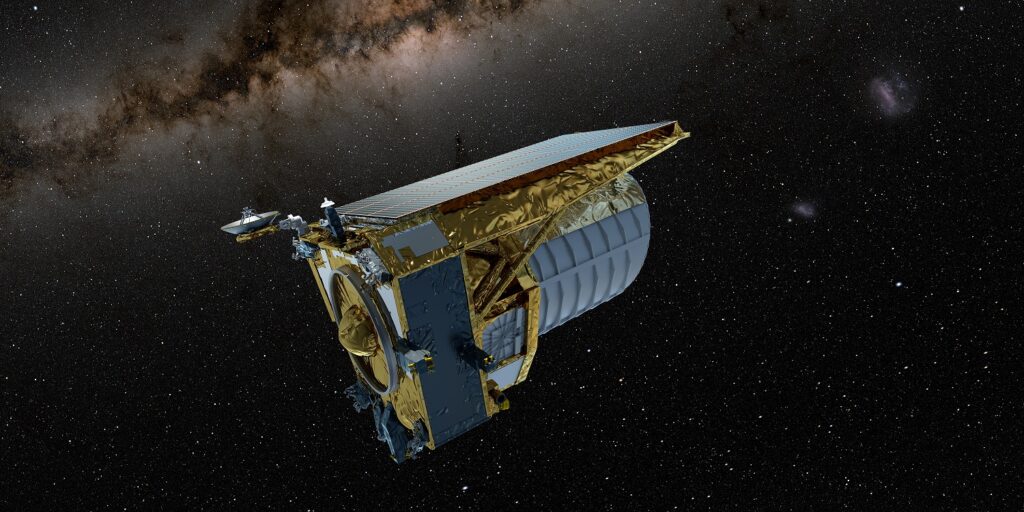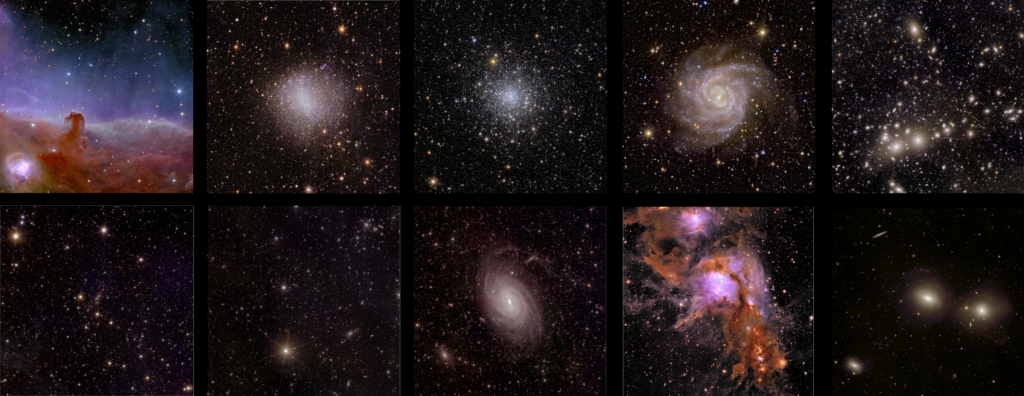Press Release: First science results and exclusive ERO data
2024-05-23, Euclid Consortium
PDF version of press release text available here
Euclid Consortium: First science results and exclusive ERO
data from the Euclid space telescope

Today, the Euclid Consortium releases early scientific papers based on observations made by the Euclid telescope. A number of scientifically exciting targets have been observed and analyzed by scientists of the Euclid Collaboration during an Early Release Observations phase, giving a glimpse of the unprecedented power of this telescope meant to provide the most precise map of our Universe over time. Exciting scientific results about the discovery of free-floating planets, the population of globular clusters around nearby galaxies, the discovery of new dwarf and low-surface brightness galaxies, the distribution of dark matter and intracluster light in clusters of galaxies, or high-redshift magnified lensed galaxies are described in a series of 10 scientific publications. In addition to these first and promising scientific results, the Consortium also publishes on this day the mission’s reference papers that confirm the outstanding performance of Euclid.
The Euclid Consortium
In collaboration with the European Space Agency (ESA), the Euclid Consortium has been planning, building, and is currently operating the Euclid space telescope mission. This mission aims at mapping the extragalactic sky over a period of six years, providing unique data that can offer new insights into dark energy and dark matter. Launched on July 1st, 2023, the telescope successfully began its cosmological survey on February 14th, 2024.
The Euclid Consortium comprises more than 2600 members, including over 1000 researchers from more than 300 laboratories in 15 European countries, plus Canada, Japan and United States, covering various fields in astrophysics, cosmology, theoretical physics, and particle physics. Today, the efforts of the Collaboration can be shown through a first suite of Euclid publications. It is an immense pleasure to announce the release of its first papers describing the Euclid mission, its scientific instruments and its performance based on observations made by Euclid. Five of them will serve as key reference throughout the mission and beyond, while the other ten showcase the research conducted with the Early Release Observations (ERO) data.
Reference papers
The Overview paper provides a summary of the Euclid mission, covering its scientific goals, spacecraft details, survey planning, data products, planned analysis, and more. It will remain, during the whole mission, a reference for the broader scientific community interested in Euclid data and scientific results. “It summarizes the outstanding achievement of more than 10 years of development to produce a scientific mission that will perform better than our expectations and put Euclid at the forefront of the exploration of the dark Universe, but also in almost all fields of astronomy”, Yannick Mellier, Euclid Consortium Lead, says.
The VIS, NISP and NISP Calibration papers describe Euclid’s instruments’ specifications, design, development, and roles within the mission. The VIS (for Visible) instrument, a 609 Megapixel optical-band imager; and the NISP (for Near Infrared Spectrometer and Photometer) instrument, a multiband photometer also capable of slitless spectroscopy, are Euclid’s key features. They provide exquisite data to map the large-scale structure of our Universe over time to constrain the nature of dark energy and the validity of general relativity on cosmological scales. Performance verification tests indicate that both instruments are operating at fully in line with expectations.
Finally, the SIM paper introduces the Euclid Flagship simulation, a simulated catalog of billions of galaxies based on the largest cosmological simulation ever conducted, designed to prepare the scientific exploitation for the Euclid mission. Developed to train and validate the ground segment algorithms before the launch, simulations are now used to measure, calibrate and correct systematic biases.
Early Release Observations images, data and papers
An Early Release Observations program was conducted during Euclid’s first months in space as a first look at the depth and diversity of science Euclid will provide. A total of 24 hours was allocated towards specific targets chosen to produce stunning images, also relevant for scientific research. Five of these images were released in November, 2023 (see ESA’s press release of November 7, 2023). The remaining five are being published today, May 23rd, 2024, by ESA (see ESA’s press release of May 23rd, 2024).

The Euclid Collaboration has now concluded some of the early scientific analyses that were carried out with these ERO data, and publicly releases the associated papers and data today. Seventeen targets, from galaxy clusters, nearby galaxies, globular clusters, to star-forming regions, have been observed and analyzed. “As scientists of the Euclid ERO programme, we were highly motivated and were working non-stop analyzing the data to make great science out of the fantastic Euclid images,” claims Teymoor Saifollahi, postdoc fellow at the Observatory of Strasbourg.
Some of the science includes: new-born free-floating planet candidates, newly identified extragalactic star clusters, new low-mass dwarf galaxies in a nearby cluster of galaxies, and the discovery of very distant bright galaxies (seen during the first billion years of the Universe). “The broad spectral coverage, spanning from visible to near-infrared wavelengths, coupled with an exceptionally wide field of view, enables the discovery of the brightest and most massive galaxies in the early Universe.” says Hakim Atek, researcher at Paris Astrophysics Institute. “The ERO imaging of the Perseus cluster demonstrate the unique capability of Euclid to concurrently detect and characterize large samples of dwarf galaxies, their nuclei, and their globular cluster systems, allowing us to construct a detailed picture of the formation and evolution of galaxies over a wide range of mass scales and environments.” adds Francine Marleau, scientist at the Institute of Astro and Particle Physics in Innsbruck.
These science outputs demonstrate Euclid’s excellent performance and ability to deliver the expected precision for various targets, as well as the smooth and effective analysis of the data within the Euclid Collaboration, auguring well for the mission’s future. “The Euclid Early Release Observations are only the tip of the iceberg of discoveries to come from the Euclid surveys already underway.” affirms Leslie Hunt, scientist at Arcetri Astrophysical Observatory in Florence. In fact, all these spectacular results were obtained in less than 0.1% of Euclid’s allocated survey observing time.
These papers, which have all been subject to the internal peer review process, are available at Euclid Consortium Publications (and below) and will appear as pre-publications on the ArXiv later today. The images and science-ready catalog are available for download from ESA.
Future milestones for the Euclid mission
The next data release from the Euclid Consortium will concern Euclid’s nominal survey. A first worldwide quick release is currently planned for March 2025, while a wider data release is scheduled for June 2026. At least three other quick releases and two other data releases are expected before 2031, which corresponds to a few months after the end of Euclid’s initial survey.
For more information, please contact Tancrède Menard, press@euclid-ec.org.
Euclid reference papers (link to arXiv):
- Euclid. I. Overview of the Euclid mission, Euclid Collaboration: Mellier et al.
- Euclid. II. The VIS Instrument, Euclid Collaboration: Cropper et al.
- Euclid. III. The NISP Instrument, Euclid Collaboration: Jahnke et al.
- Euclid. IV. The NISP calibration unit, Euclid Collaboration: Hormuth et al.
- Euclid. V. The Flagship galaxy mock catalogue: a comprehensive simulation for the Euclid mission, Euclid Collaboration: Castander et al.
Euclid Early Release Observation science papers (link to arXiv):
- Euclid: Early Release Observations – Programme overview and pipeline for compact- and diffuse-emission photometry, Cuillandre et al.
- Euclid: Early Release Observations – A glance at free-floating new-born planets in the σ Orionis cluster, Martin et al.
- Euclid: Early Release Observations – Unveiling the morphology of two Milky Way globular clusters out to their periphery, Massari et al.
- Euclid: Early Release Observations – Deep anatomy of nearby galaxies, Hunt et al.
- Euclid: Early Release Observations – Globular clusters in the Fornax galaxy cluster, from dwarf galaxies to the intracluster field, Saifollahi et al.
- Euclid: Early Release Observations – Overview of the Perseus cluster and analysis of its luminosity & stellar mass functions, Cuillandre et al.
- Euclid: Early Release Observations – Dwarf galaxies in the Perseus galaxy cluster, Marleau et al.
- Euclid: Early Release Observations – The intracluster light and intracluster globular clusters of the Perseus cluster, Kluge et al.
- Euclid: Early Release Observations – A preview of the Euclid era through a magnifying lens, Atek et al.
- Euclid: Early Release Observations – NISP-only sources and the search for luminous z = 6 – 8 galaxies, Weaver et al.
Press inquiries:
Tancrède Menard, press@euclid-ec.org (EC EPO interim lead)
Full press contact overview:
Press Contacts incl. national contacts

